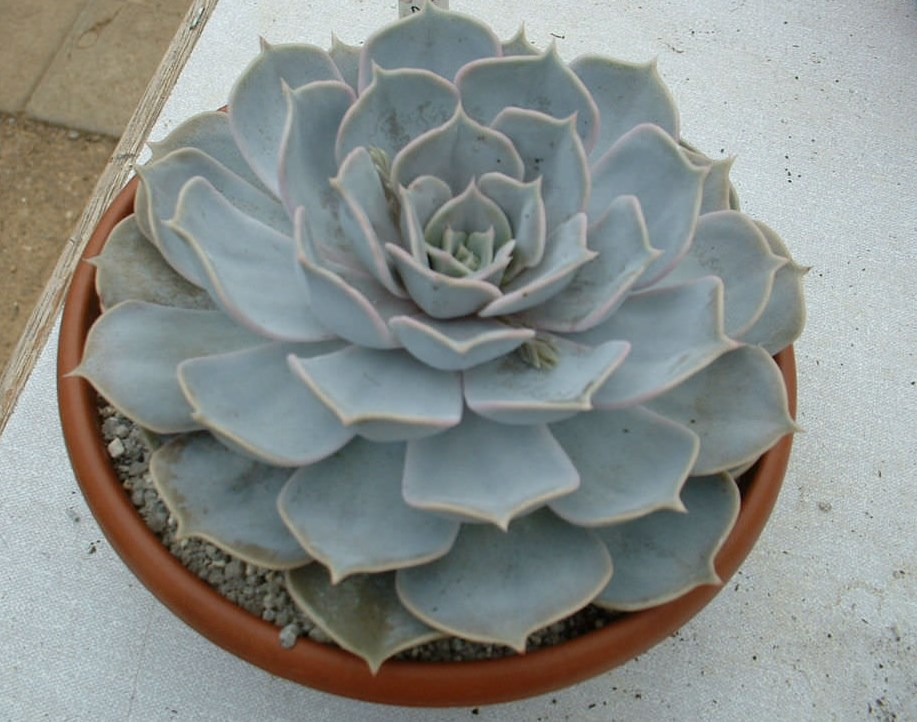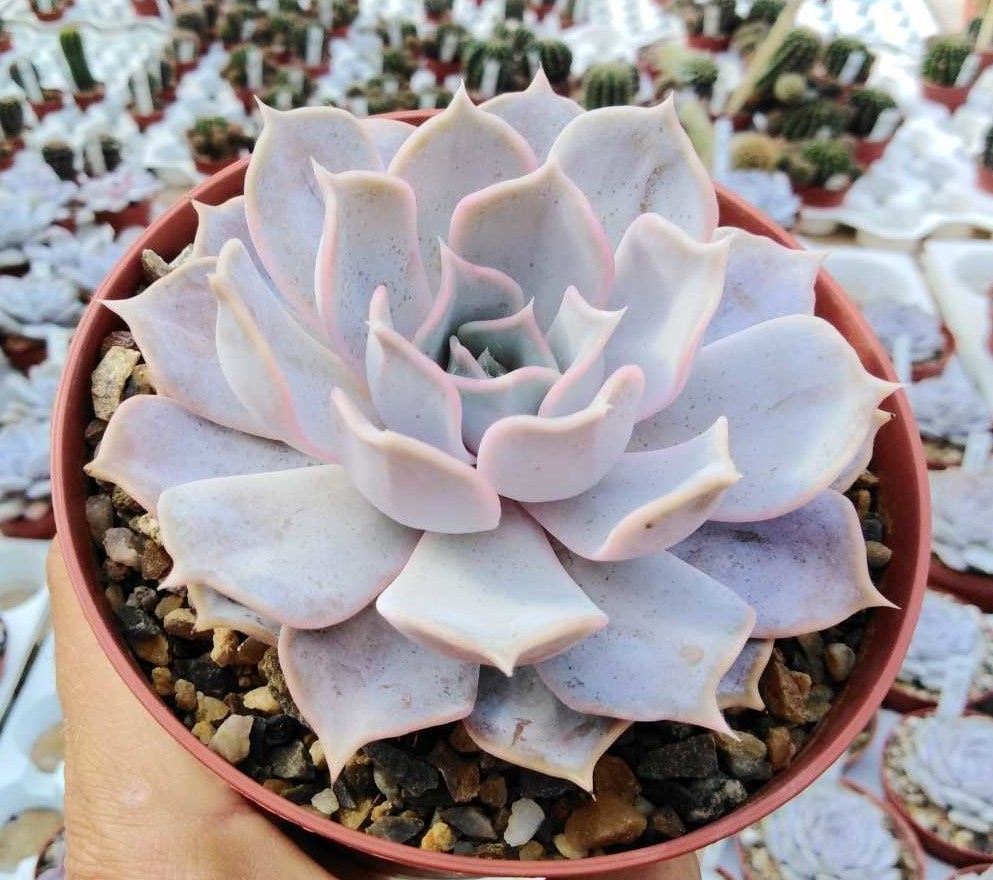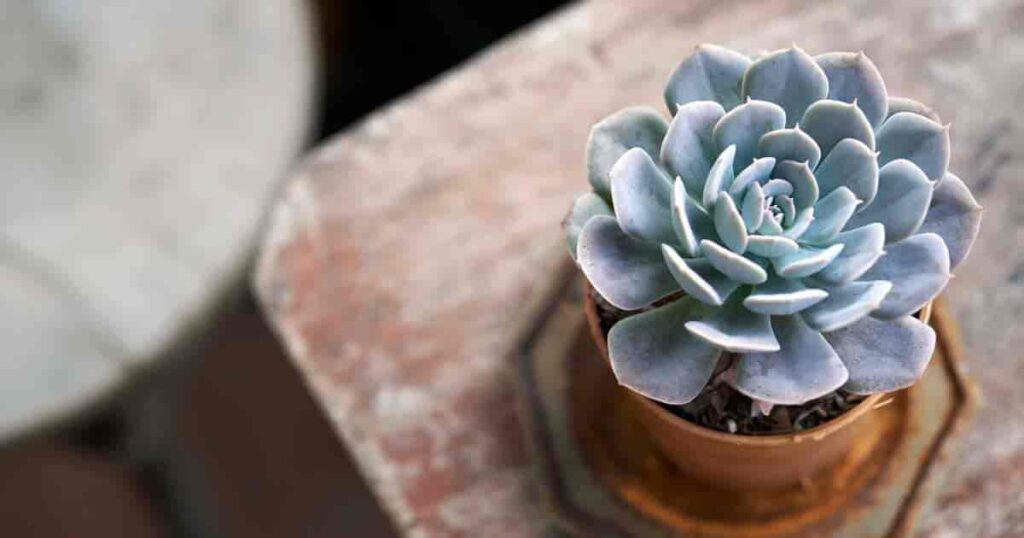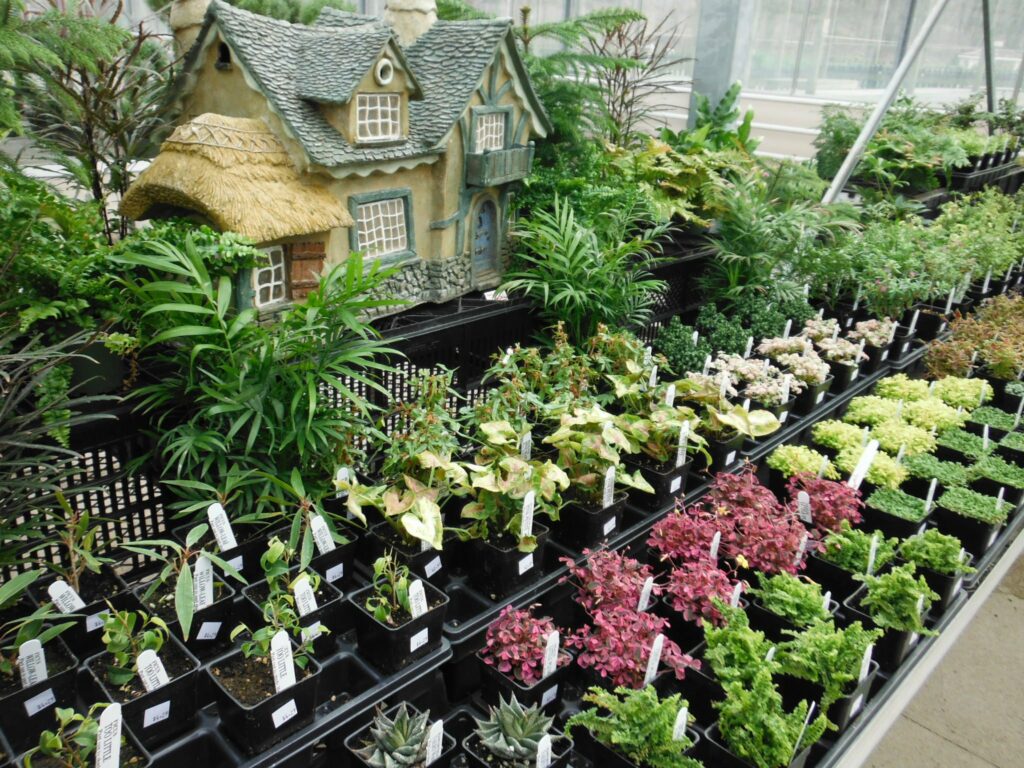Echeveria is a type of succulent that is very popular and easy to grow. When it comes to beauty and uncomplicated care, Echeveria plants are not going to disappoint, and this is especially true of Lilac or Ghost Echeveria. If you want a bold-looking plant for a garden plot or a decorative container, but don’t want to hassle over its many finicky requirements, this is the plant for you.
How to Identify Ghost Echeveria
Like most other types of Echeveria succulents, Ghost Echeveria grows in a tight rosette with spoon-shaped leaves. Ghost Echeveria can be distinguished from other similar-looking plants by its color. Its leaves are a grayish purple hue that is close to lilac, which is why it is also known as a Lilac Echeveria.
Where Does Ghost Echeveria Grow
This plant is a native of northern Mexico and parts of Texas.
Uses of Ghost Echeveria
Ghost Echeveria can be used for decorative features. Just like other types of purple succulents, it is beautiful as a stand-alone plant or as part of a group.
How to Grow Ghost Echeveria from Seed
These succulents can be germinated from seedlings in a few very simple steps. These steps are:
- Purchase or gather seeds from a flowering Echeveria plant.
- Select potting soil that is designed for succulents and cacti
- Select a seed tray for growing the seedlings
- Plant the seeds in the potting soil
- Set the seed tray in a warm (70 degrees Fahrenheit) spot with indirect sunlight
- Water with a plant mister so that the seeds do not get moved around
It will take approximately three weeks to see any signs of successful germination from the planted seedlings. Evidence that the seeds are sprouting will be tiny leaves above the soil.
Once the seedlings have grown into healthy plants, the following care must be taken:
- Move the new plants to a larger container
- Feed the new plants with a diluted fertilizer during their growing season. This is usually springtime.
- Water the plants only when the soil is dry.
Ghost Echeveria Growing Conditions

For these plants to grow and thrive, they will need to be set in a place with full to partial sunlight, plenty of warm air, and well-draining soil.
When to Plant Ghost Echeveria
Spring and Summer are the best times to plant or repot Ghost Echeveria. These are the times of the year when there will be the best amount of sunlight and heat.
How to Plant Ghost Echeveria
When planting a Ghost Echeveria, it is a good idea to keep these tips in mind.
- Use a container that has drainage holes or select a ground plot that will drain water
- Use potting soil that is well-draining
- Use gravel at the bottom of the container or ground plot for extra drainage (optional)
- Before planting a Ghost Echeveria in the ground, make sure you live in an area where it can grow outside all year round. Ghost Echeveria can grow in USDA Hardiness Zones 10a to 11b, so make sure this corresponds with the area where you live.
Once you have selected where to plant your Ghost Echeveria and the proper potting soil, follow these steps to plant it:
- Place some gravel at the bottom of the container or the ground plot selected
- Place the potting soil on top of the gravel
- Make a small hole in the potting soil
- Set the plant into the hole
- Cover the roots with potting soil and make sure the plant is secure in its new home
- Water the plant until the soil is moist but not soggy
Ghost Echeveria Water Requirements
Just like most other succulents, Ghost Echeveria is susceptible to root rot, so it is best to allow them to dry out completely between watering sessions. The best way to water one of these that is in a container is to use the soak and dry method. The steps for doing this are as follows:
- Fill a tray or a sink with a few inches of water.
- Set the plant container in the tray making sure that the water is not so deep that it will run over the top of the container. The point of watering in this way is so that the roots will soak up the water and the leaves will not get wet.
- Let the plant soak in the water for fifteen minutes. This will allow the root system to soak up water from the bottom of the container.
- Take the plant container out of the water.
- Place the plant container in a spot where the excess water can drain from the hole in the bottom.
- Repeat this only when the soil around the plant is dry.
Ghost Echeveria Sun Requirements

Plants that are kept indoors will need to be placed in a window that gets at least six hours of bright sunlight each day. Plants that are kept outdoors will do well in full to partial sun. As with any plant, it is best to acclimatize it to the full sun so that it doesn’t dry out or get sunburnt.
Best Ghost Echeveria Fertilizer
These succulents are not fussy about feedings; they simply do not need much fertilization. However, a little fertilization during the growing season can help assist with their growth. If you choose to fertilize your Ghost Echeveria, follow these guidelines:
- During the growing season, use a fertilizer that is low in nitrogen and is water-soluble. Miracle-Gro Water Soluble Bloom Booster is an excellent option.
- Only fertilize a Ghost Echeveria during its growing season (Spring)
Best Ghost Echeveria Companion Plantings
While these particular succulents do look lovely as solitary plants, it can be really fun to use their purplish hue as a complementary color scheme alongside other plants. If you are looking for some other types of plants that will be uncomplicated to grow and will look fabulous with your Ghost Echeveria, try one of these options.
Sedeveria ‘Lilac Mist’

This succulent is formed into a compact rosette made from round chubby leaves. Its coloring is mostly a cool green-gray, but it dances into light shades of purple towards its center. The soft and welcoming colors and shape of this hybrid succulent make it the ultimate companion planting for Ghost Echeveria. Just imagine these two plants and their shades of lilac next to one another and how compelling their beauty will be.
Pros:
- Does not require much maintenance once it is established
- Requires similar amounts of heat and sunlight as Ghost Echeveria
- Requires the same type of soil as Ghost Echeveria
Cons:
- Is susceptible to overwatering and root rot
- It is not cold hardy
Senecio Mandraliscae ‘Blue Chalksticks’

This succulent from South Africa is dense and beautiful. It makes the best ground cover for lawns that have spots that are difficult for growing anything. The blue-green color of Blue Chalksticks is lovely enough, but this plant has a special surprise in the summertime when it produces tiny white flowers. Growing a Ghost Echeveria alongside some of these is truly a beautiful arrangement.
Pros:
- It is drought tolerant
- It is great for using as ground cover
- It is easy to propagate from stem cuttings
- It can be grown in containers or in a ground plot
- It produces flowers
Cons:
- It grows quickly and can take over a lawn or garden
Echeveria Elegans ‘Mexican Snowball’

This succulent looks a lot like Ghost Echeveria because its leaves are also spoon-shaped and they grow in the form of a rosette. It is their common features that will make them excellent companion plants.
Pros:
- It propagates quickly by offsets
- It blooms bell-shaped flowers each year and survives
- Its leaves can turn shades of red with healthy stress
- It thrives in the same hardiness zones as Ghost Echeveria
- It requires the same water, soil, and sun care as Ghost Echeveria
Cons:
- It is susceptible to several pests, including aphids, mealybugs, and vine weevils
- It is not cold hardy
Ghost Echeveria Diseases and Common Problems
The most common issues faced by Ghost Echeveria are:
- Fungus Gnats
- Mealybugs
- Spider mites
- Scale
- Root rot
Ghost Echeveria Treatments and Maintenance

If your Ghost Echeveria gets an infestation of any of the common pests that attack it, here are the best ways to treat it:
Fungus Gnats
If you notice little gnats flying around the surface of the soil where your plant is growing, it may have an infestation of gnats. While the mature gnats don’t really bother the plant directly, their larvae will.
To get rid of fungus gnats, you will need to set out a jar of Apple Cider Vinegar. Put a lid on the jar and poke tiny holes into the lid, just big enough for the gnats to get through (a spice jar lid works nicely for this). The gnats will be attracted to the vinegar but they will not be able to escape the jar and they drown in the liquid.
Mealybugs
If you notice white fluff growing on your plant, you may have a mealybug infestation. To rid your plant of these pests, apply rubbing alcohol to any places on the plant where you see the white fluff or the actual insects. There is also the option of spraying the plant with a solution of diluted dish soap and water.
Mealybugs can also be hiding in the roots of the plant. If this is the case with your plant, it will require that you remove the plant from its container, shake off the soil, wash the roots with diluted alcohol or soapy water, allow the plant to dry, and then, replant it in new, fresh soil.
Note: Ridding your plant of mealybugs may take a few treatments over several weeks.
Spider Mites
The sign of an infestation of spider mites is that the plant will turn a lighter color, even white or silvery. There will also be brown spots and spider webbing on the plant. If you notice any of these signs on your plant, treat the infestation just as you would an infestation of mealybugs.
Scale
These are tiny insects that will appear as small, brown bumps on your succulent. If you notice these, remove the visible insects and start cleaning the plant with diluted alcohol or soapy water. If the roots of the plant have been infested, you can clean them in the same manner that you would in the case of a mealybug infestation.
Root Rot
Dealing with root rot is a very difficult process that doesn’t guarantee success, so it is always best to prevent it from even occurring. To prevent root rot, take the time to learn how to properly water a succulent. But, if it has already begun, follow these steps to help the plant survive:
Dry Out the Plant
This technique can be done if the root rot has not spread to the stems. What it entails is taking the plant out of the soil and letting them layout for a few days so the excess water will evaporate. Once this has been done, they should be replanted in fresh, clean, and dry soil.
Remove Rotten Parts
Trim off any areas of the plant that are rotting, then allow the plant to callous for a few days. Without letting it callous, the chances of the succulent surviving are very slim.
This technique should be done after the plant has been trimmed of all its rotted areas and allowed to callous. It will require that you dust a little sulfur on its root system to help prevent the spread of microbes.
This should be the last resort treatment, but it could save your plant when done right.
Ghost Echeveria Repotting Instructions
To replant a Ghost Echeveria, follow these steps:
- Select a new container that is well-draining and will allow the plant to have room to grow.
- Select a potting soil mix that is well-draining.
- Carefully remove the plant from its current container.
- Fill the new container with the potting soil mix.
- Create a small hole for the plant(s) to rest in.
- Carefully set the plant into the hole.
- Spread the potting soil around to make sure the hole is filled and the plant’s roots are covered.
- Water in the soak and dry method.
- Place the container in a warm, partially sunlit spot.
Where to Buy Ghost Echeveria Seeds Online
If you plan to purchase some Moonstone Succulent seeds, try one of these online shops:
Where to Buy Ghost Echeveria Plants Online
If you plan to purchase a Moonstone Succulent plant, try one of these online shops:
FAQs
Question: Is Ghost Echeveria Toxic?
Answer: No, these are not considered toxic to animals or humans.
Question: Does Ghost Echeveria Produce Blossoms?
Answer: Yes, these plants do produce lantern-shaped blooms in late winter and early spring. The blooms are usually coral-colored and grow on a long red stem.
Question: How Do You Propagate a Ghost Echeveria?
Answer: We have covered that these plants can be propagated by seeds, but they are most commonly propagated via leaf cuttings. The steps for doing this are:
– Gently twist off a leaf from the main plant in a way that will keep the base of the leaf attached
– Select a container that has holes for drainage
– Select potting soil that is designed for succulents and cacti
– Fill the pot with the potting soil
– Place the leaf on top of the potting soil
– Set the container in a warm spot that gets bright but indirect sunlight
– There is no need to water the leaf-cutting until new roots have formed
– Once roots begin growing, the leaf can be lightly watered every few weeks
– A new rosette should form on the end of the leaf-cutting after a month
– Once the leaf has shriveled and the new rosette looks healthy, they can be separated from one another
– The new rosette can be replanted in a container with succulent potting soil and cared for like a mature plant
Concluding Thoughts
Ghost Echeveria is another wonderfully uncomplicated and beautiful gift from the natural world. So, why not gift yourself or someone you love with this lovely purple-hued plant?
Research Citations
Read more guides here:
- Sedum Rubrotinctum (Jelly Bean Plant): How To Care For It Best
- Gymnocalycium Mihanovichii (Moon Cactus): Easy Care Tips
- Pachyphytum Oviferum (Moonstone Succulent): Easy Tips For Plant Care
- Lophocereus Marginatus (Mexican Fence Post Cactus) - January 10, 2022
- Best Cactus Fertilizer Guide - January 9, 2022
- Selenicereus Grandiflorus (Queen of the Night) - January 3, 2022


